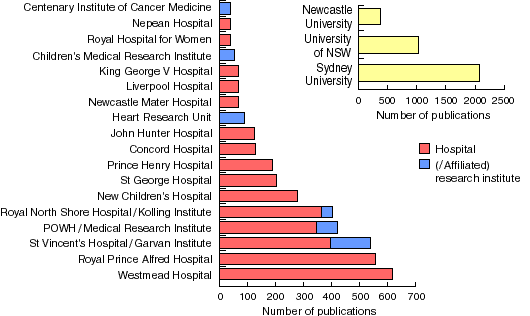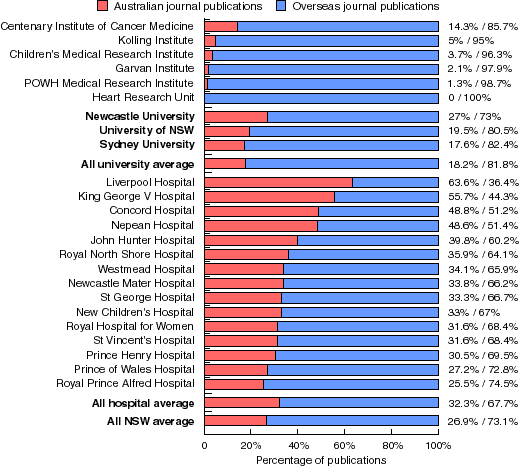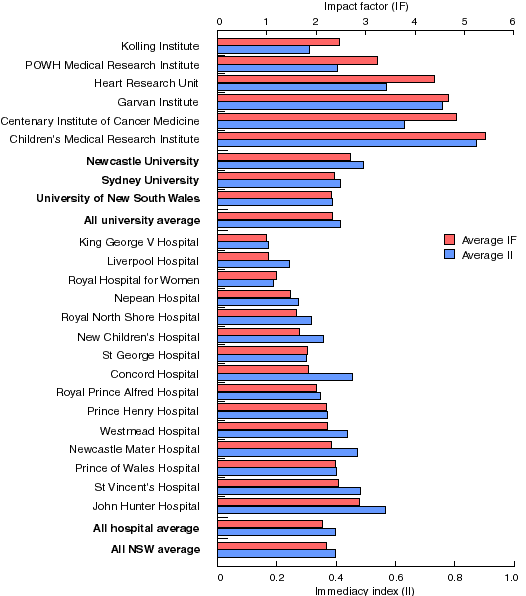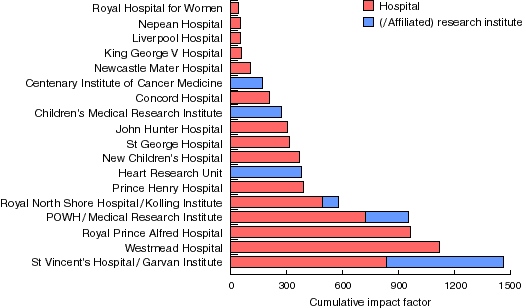|
 Medical Research Perspectives Medical Research Perspectives
Medical research in New South Wales 1993-1996 assessed by Medline
publication capture
Emmanuel J Favaloro
MJA 1998; 169: 617-622
Abstract -
Introduction -
Methods -
Results -
Discussion -
Conclusions -
Acknowledgements -
References -
Author's details
-
-
More articles on Informatics and computers
| |
Abstract | |
Objectives: To assess medical research publication
output in New South Wales (NSW).
Design: Analysis of publication information from the
Medline indexing database, 1993-1996 inclusive.
Setting: Teaching hospitals and affiliated
universities and medical research institutes within NSW, the major
sites for NSW medical science publications.
Major outcome measures: Cumulative number and location
of Medline-identified publications; journal citation indices
(impact factor and immediacy index).
Results: 8860 published articles were captured for the
analysis period. Universities and hospitals accounted for most of
the publications (n = 7755). A mean of 73.1% (range, 36%-100%)
of all articles were published in overseas journals, and the rest in
Australian journals. This average trend applied to most
universities and teaching hospitals, whereas research institutes
published almost exclusively in overseas journals. Average
publication impact factor values for most universities and teaching
hospitals were around the average value for all NSW publications
(2.203). The range for teaching hospital publications was
1.000-2.823, but for the overseas-publishing medical research
institutes it tended to be higher (2.480-5.423). Immediacy index
data yielded similar findings.
Conclusions: The universities and teaching hospitals
account for most of the medical publications arising from NSW, and
also those appearing in Australian journals. Thus, these sites
provide the bulk of Australian medical practice end-user
information. In contrast, the medical institutes concentrate on
publishing in overseas journals with higher and quicker citation
rates (higher impact factor and immediacy index).
|
Introduction | |
The Medline database can be used to capture research publications
arising from within one institution or the search can be expanded to
include, for example, all Medline-held publications from one State.
Further, to help analyse publication activity, publication data
derived from Medline searches can be merged with markers of
publication citation, such as "impact factor" and "immediacy
index". This latter information comes from the Institute for
Scientific Information (ISI; Philadelphia, USA), which catalogues
most of the major research journals in Science Citation Index (SCI)
publications,1 and publishes "impact
factor" and "immediacy index" data. Data on impact factors are often
also used as surrogate markers of publication "quality", although
there is much debate about the validity of this approach.2-5 Recently, Bourke and Butler analysed individual article citation
rates as a measure of basic medical and health sciences research in
Australia and concentrated largely on universities and high profile
research institutes.6 Although these authors have
produced several other reports analysing Australian research
activities,7 none has looked
specifically at teaching hospitals, "affiliated" research
institutes (defined as the "research arm" of the hospital) and
associated universities within New South Wales (NSW).
This article reports the results of such a sampling analysis.
|
Methods
| |
A complete description of the methods used is beyond the scope of this
report. In brief, the Medline publication indexing database
(Silverplatter version) was used to capture "quantitative"
research publication information. This database indexes most major
journals in medical and related fields (veterinary, pathology and
cell science), and each publication indexed includes the primary
author's address.
A hospital-affiliated medical research institute was defined as
such if more than a third of its publications included the teaching
hospital as part of the Medline address field. That is, the medical
research institute itself, and its researchers, clearly recognised
the affiliation within the context of the publication. Adoption of
this strict criterion resulted in exclusion of some research
institutes, or their not being identified as hospital-affiliated
sites, despite being "popularly perceived" as affiliated with a
particular teaching hospital. The teaching hospitals, their
affiliated universities and medical research institutes included
in this report are listed in Box 1.
Data capture: The approach which was found to best capture
publication data was to use (i) general ("primary") locality markers
(ie, the terms "New South Wales", "NSW", "Sydney"), and (ii) separate
specific ("secondary") locality markers (ie, names of "suburbs" in
which the medical research organisations were located). This led to
more complete capture of relevant publications than use of specific
organisational names because of inconsistencies in the
organisational names in the publications (eg, University of Sydney
v. Sydney University, etc). Captured data were then merged with
journal citation data.
Years of analysis: Medline capture and analyses were conducted for
the years 1993 to 1996 (inclusive), as these were the most recent four
consecutive years for which SCI-published impact factor and
immediacy index information was available.
Subsequent analysis: Applicable publications were downloaded to a
personal computer, and a composite database was constructed
specifically for analysis of derived information.
Author's address: Author's address, and thus research institution
location, was defined essentially as indicated by the downloaded
author's address and Medline publication information, always
attempting to be as objective as possible. If a publication noted
Sydney University as the author's address, then Sydney University
was the designated publication address. Where multiple authors'
addresses were noted then the address was "shared" (Box 2).
Analysis of research output and outcome measures:
Research output
can be assessed in various ways according to its underlying purpose.
Thus, several objective analyses were undertaken to answer separate
questions, including:
|
Results
| |
Publication output
The composite NSW-derived Medline-captured database (1993-1996
inclusive) showed that "medical, veterinary, pathology and cell
science" researchers (having given one of various localities within
NSW as their address) published 8860 articles in this period.
A total of 7755 of the NSW-based publications captured by Medline
arose from the universities and hospitals. Figure 1
shows data for teaching hospitals and research institutes with more
than 35 publications, and Figure 2
shows data for universities affiliated with these research sites.
| Figure 1: Medline-captured publications arising from NSW teaching hospitals and medical research institutes (1993-1996 total; only those sites with more than 35 publications over this period are shown). Data shown as a composite bar graph for those hospitals with an affiliated research institute (as defined in Methods). POWH=Prince of Wales Hospital.
Figure 2 (inset): Medline-captured publications arising from NSW universities affiliated with the research sites in Figure 1 (1993-1996 total).

| |
Overseas v. Australian publication
More than 70% (73.1%; range, 36%-100%) of the research publications
from NSW researchers appeared in overseas journals and the remainder
in Australian journals, with a similar division evident across
different hospital and university sites (Figure
3). In contrast, the medical research institutes tended to
publish almost exclusively in overseas journals.
|
Figure 3: Medline-captured publications arising from NSW research.Percentage of journal articles in Australian journals v. overseas journals; data shown are 1993-1996 average. Data shown separately for the hospitals, universities and research institutes in Figures 1 and 2. POWH=Prince of Wales Hospital.
 | |
Journal citation data
Excluding publications not listed in the SCI1 publication statistics,
the NSW-based average impact factor (all NSW Medline-captured
journal publications) was 2.203 (1993-1996 averaged). Averaged
impact factor and averaged immediacy index data for each research
organisation are shown in Figure 4.
For comparison, data for hospital, university and medical research
institute sites are shown separately.
|
Figure 4: Average impact factor and immediacy index (1993-1996 average) for Medline-captured publications arising from NSW research. Data shown separately for the hospitals, universities and research institutes in Figures 1 and 2. (Average impact factor = cumulative impact factor of all journal publications for each research site divided by total number of journal articles captured for that site. Average immediacy index = cumulative immediacy index of all journal publications divided by total number of journal articles captured for that site.) POWH=Prince of Wales Hospital.

| |
Average impact factor values for most hospital sites (around 2) are
similar to those generated from each of the affiliated universities.
Indeed, the "all hospital average" impact factor was similar to the
"all university average" impact factor. In general, the research
institutes' tendency to publish in overseas-based journals
increased their impact factor averages (Figure
4).
The pattern of immediacy index data closely followed the pattern
observed for impact factor (Figure 4).
|
Discussion
| |
General findings
This report confirms the importance of the NSW teaching hospital
system in ongoing medical research and teaching activity. Together
with their affiliated universities, these sites provided the great
bulk of medical publications arising from NSW. While the research
institutes tended to target "international" journals directed at
specialised scientific research, teaching hospitals and their
affiliated universities targeted Australian journals as well.
This means that the "non-research institute" sites play the
predominant role in providing local educational support to
Australian health practitioners via journals published and widely
read within Australia. Although publishing in Australian journals
often carries less international "prestige" or "visibility" than
publishing in overseas journals, Australian publications play an
important role in education of medical, scientific, nursing and
allied health practitioners. Furthermore, Australian
publications have particular relevance to Australian medical
practice, with reporting of specific local data or locally relevant
issues (eg, local epidemiological or local infectious disease
data).
Advantages and disadvantages of the method
Data were collected by a well recognised and accepted method of
capturing publication information. The Medline database has
previously been used with success in bibliometric studies to show
publication trends,8-10 and has been
consistently shown to provide the strongest health discipline
indexing coverage when compared with other databases.11-15 Based largely on internal comparative research estimates, the
method used would be expected to capture in excess of 60% of the
published research output from NSW medical researchers, and is thus
only an approximation of the level and scope of all such activity.
Missing would be:
- Valid research publications not
indexed by any indexing service (eg, reference book chapters,
articles in popular science or society journals); and
- References in non-Medline indexing services.
Moreover, the Medline indexing service may exclude certain journals
preferentially favoured by some research organisations.
However, an advantage of the method is that it does not
capture:
- Non-standard publications (which would
complicate any analysis);
- Low grade ("self-promotional") publications which may be included
in subjective analyses (eg, publications in annual research
reports, "in press" publications, conference presentations); and
- It minimises the likelihood of "tally duplication" because of
research collaborations.
Some exclusions or errors in location assignment will have occurred
despite extensive cross-checking to certify a publication's
origin. I relied almost entirely on authors to provide their own
affiliation information. However, this was not always provided, or
the address details were not always consistent. Finally, Medline
catalogues only the primary author's address, so that publications
of research collaborations for which the base research site (ie,
principal author(s) address) is (i) outside the Medline capture
search limit, or (ii) does not contain collaborating ("secondary")
authors' addresses will be excluded from the tallies from these
institutions.
Importantly, while research output will necessarily be
underestimated by this process, it would be expected that (apart from
the limitations noted above) no individual hospital or other
research organisation would be differentially disadvantaged in a
direct-comparison process. The process employed within this report
can easily be validated by any institution should there be any concern
regarding objectivity or validity.
Journal citation analysis
The research institutes tended to target journals with higher and
quicker citation rates (ie, average impact factor and immediacy
index, respectively, was highest in their chosen journals), partly
because these institutions published almost exclusively in
overseas journals. These tend to have higher citation rates, and thus
higher impact factor and immediacy index values (as shown by a
breakdown of average impact factor values for SCI-listed journals
with publications from NSW in 1993-1996 found by Medline capture)
(Box 4). Impact factor listings derive from the United States and most
strongly favour US journals.3 Recalculating average research site impact factor data for overseas
publications only (ie, excluding Australian publications) tends to
increase the relative average impact factor value for most hospital
sites by between 0.5 and 1.0, and thus brings their average values very
close to those of the research institutes. The medical research
institutes concentrate more specifically on publishing specialist
research work targeted at other research scientists, which
cultivates further research activities and citing of publications
by research peers, maintaining these journals' high impact factors.
The core hospital sites publish this sort of research as well as
publishing "generalist education" or "local content" papers aimed
at non-research ("end-user") health specialists. Both forms of
publication are valid and valuable, although only the former has high
"international visibility".
That immediacy index data largely follow the pattern of the impact
factor data suggests that use of both citation markers may not be
required in subsequent analyses, and that journals with high
citation rates (impact factor values) also have quicker citation
(immediacy index) values (confirmed by review of the Medline
database and SCI publications1 -- data not shown).
Citation values as markers of research quality
Publication citation data are popularly used as a surrogate marker of
publication "quality" on the premise that the higher the citation
rate, the greater the scientific quality of the articles in that
journal. The validity of this approach can be questioned and has given
rise to much recent debate.2-5,16-18 The main problems
relate to:
- Accessibility of journals and journal listing bias, with
only journals in the SCI database included in the analysis and
listings strongly favouring English language journals published in
the United States;
- Inferences that a journal's impact factor or citation pattern
reflects each article's citation pattern (which is not the case; also
article citation rates determine journal impact factor, not the
other way around), and that citation reflects scientific quality
(not necessarily -- an article may be cited often to exemplify a
scientific flaw);
- Citation bias, as there is no correction for the influence of
self-citation in impact factor calculations (authors and journals
may both favour self-citation); and
- Specialty bias, as impact factors differ according to the research
field.
There are many other potential traps.2-5 However, the impact
factor process is relatively easy, and it offers an achievable
comparison process, so its popular use as a quality marker persists.
In practice, the impact factor may better reflect "international
visibility" than "scientific quality". Furthermore, use of
averaged data (eg, average impact factor and average immediacy
index) perhaps shows "average visibility". A fairer comparative
process might be to correlate total (or cumulative) impact factor as a
marker of "total visibility", as shown in Figure 5.
| Figure 5: Total, (ie, cumulative) impact factor (1993-1996 period) for Medline-captured publications arising from NSW research. Data shown as a composite bar graph for those hospitalswith an affiliated research institute (as defined in Methods). Cumulative impact factor derived by addition of individual impact factor values from all journal publications for each research site. POWH=Prince of Wales Hospital.

| |
In a recent comparable analysis, Bourke and Butler6 assessed
Australia's basic research in the medical and health sciences, using
individual article citation rates to assess the "visibility" of
research in different general research sectors (ie, universities,
hospitals, medical research institutes, other institutions) by
calculating the average number of citations received per
publication (cpp). They also listed specific institutions with high
cpp values. Use of this more specific marker of article citation,
rather than journal citation, overcomes some of the limitations
noted above of the use of impact factor as a surrogate marker of
publication quality. However, use of cpp is still based on the premise
that a high citation rate reflects high scientific quality. With this
tool, Bourke and Butler6 concluded that "the bulk of
Australia's basic research in the medical and health sciences comes
from the universities and hospitals, but Australia's medical
research institutes, the members of AAMRI [Australian Association
of Medical Research Institutes], have the highest international
profiles". In this our data agree. Thus, while these institutes
produce publications which appear in the most highly "visible"
journals, the universities and hospitals produce the vast bulk of the
research output, and contribute most to local medical issues.
However, if, as an exercise, Australian journal publications are
excluded from the calculations, the remaining overseas-published
medical research from the universities and hospitals also appears in
these highly "visible" journals.
Finally, it is likely that some significant under-representation of
specific teaching hospital sites would have occurred in Bourke and
Butler's6 study, as "where a research
group based in a hospital with a university connection lists the
university in the address, we consistently assign the publication to
the university". In this report, publications are assigned to both
the university and the hospital, and comparisons then made
differentially. Based on the Medline database, an average of 14%
(but, on a case-by-case basis, up to 43%) of hospital publications
include a university address.
|
Conclusions
| |
This survey confirms the important contribution to medical research
and teaching made by NSW teaching hospitals. Thus, both publication
output and perceived scientific quality and visibility can be
considered as high compared with peer NSW research institutes. In
addition, it is the non-research-institute-based hospital sites
that most significantly contribute to research published in
Australia. It is hoped that the process of identifying quality
research from Australian research institutions, as outlined in this
report, will help promote research activity and its future
development at these sites, and help to set benchmark standards for
this research and teaching activity.
|
Acknowledgements
| |
The concept derives from four previous internal research review
reports to the Westmead Scientific Advisory Committee (SAC). Most of
the data analysis was performed "after-hours", and I am grateful to Ms
Beryl Dawson for her patience and understanding. Professor Tony
Cunningham and Professor Cres Eastman are thanked for their support
and encouragement. Sincere appreciation also to my colleague Dr
Brian Nankivell, who set me upon this path of discovery, and to Ms
Claire Wolczak, who sought out and found copies of the required SCI
reports.
Conflict of Interest: I am employed within one of the
institutions in this report, but have attempted at all times to be
objective.
|
References
| |
- Science Citation Index. Journal citation reports. A bibliometric
analysis of science journals in the ISI database. Philadelphia:
Institute for Scientific Information, 1993, 1994, 1995, 1996.
-
Garfield E. How can impact factors be improved? BMJ 1996;
313: 411-413.
-
Seglen PO. Why the impact factor of journals should not be used for
evaluating research. BMJ 1997; 314: 498-502.
-
Smith R. Unscientific practice flourishes in science. Impact
factors of journals should not be used in research assessment. BMJ
1998; 316: 1036.
-
Williams G. Misleading, unscientific, and unjust: the United
Kingdom's research assessment exercise. BMJ 1998; 316:
1079-1082.
-
Bourke PF, Butler L. The research enterprise: mapping Australia's
basic research in the medical and health sciences. Med J Aust
1997; 167: 610-613.
-
Research School of Social Sciences, Australian National
University, Internet webpage (URL site:
<http://rsss.anu.edu.au/>). Accessed August, 1998.
-
Sittig DF. Identifying a core set of medical informatics serials:
an analysis using the MEDLINE database. Bull Med Libr Assoc
1996; 84: 200-204.
-
Takahashi K, Hoshuyama T, Ikegami K, et al. A bibliometric study of
the trend in articles related to epidemiology published in
occupational health journals. Occup Environ Med 1996; 53:
433-438.
-
Dunn K, Chisnell C, Sittig DF. A quantitative method for measuring
clinical user journal needs: a pilot study using CD Plus MEDLINE usage
statistics. Medinfo 1995; 8: 1428-1432.
-
Schloman BF. Mapping the literature of allied health: project
overview. Bull Med Libr Assoc 1997; 85: 271-277.
-
Schloman BF. Mapping the literature of health education. Bull
Med Libr Assoc 1997; 85: 278-283.
-
Wakiji EM. Mapping the literature of physical therapy. Bull
Med Libr Assoc 1997; 85: 284-288.
-
Burnham JF. Mapping the literature of radiologic technology.
Bull Med Libr Assoc 1997; 85: 289-292.
-
Burnham JF. Mapping the literature of respiratory therapy.
Bull Med Libr Assoc 1997; 85: 293-296.
-
Hecht F, Hecht BK, Sandberg AA. The journal "impact factor": a
misnamed, misleading, misused measure. Cancer Genet
Cytogenet 1998; 104: 77-81.
-
Gallagher EJ, Barnaby DP. Evidence of methodological bias in the
derivation of the Science Citation Index impact factor. Ann Emerg
Med 1998; 31: 107-109.
-
Opthof T. Sense and nonsense about the impact factor.
Cardiovasc Res 1997; 33: 1-7.
(Received 3 Feb, accepted 20 Oct 1998)
|
Author's details
| |
Institute of Clinical Pathology and Medical Research (ICPMR),
Westmead Hospital, Western Sydney Area Health Service, Westmead,
NSW.
Emmanuel J Favaloro, BSc(Hons), PhD, Senior Hospital
Scientist, Haematology.
Reprints: Dr E J Favaloro, Senior Hospital Scientist,
Haematology, ICPMR, Westmead Hospital, Westmead, NSW 2145.
Email: emmanuelATicpmr.wsahs.nsw.gov.au
Journalists are welcome to write news stories based on what they read here, but should acknowledge their source as "an article published on the Internet by The Medical Journal of Australia <http://www.mja.com.au>".
<URL: http://www.mja.com.au/>
|
|





 Medical Research Perspectives
Medical Research Perspectives


